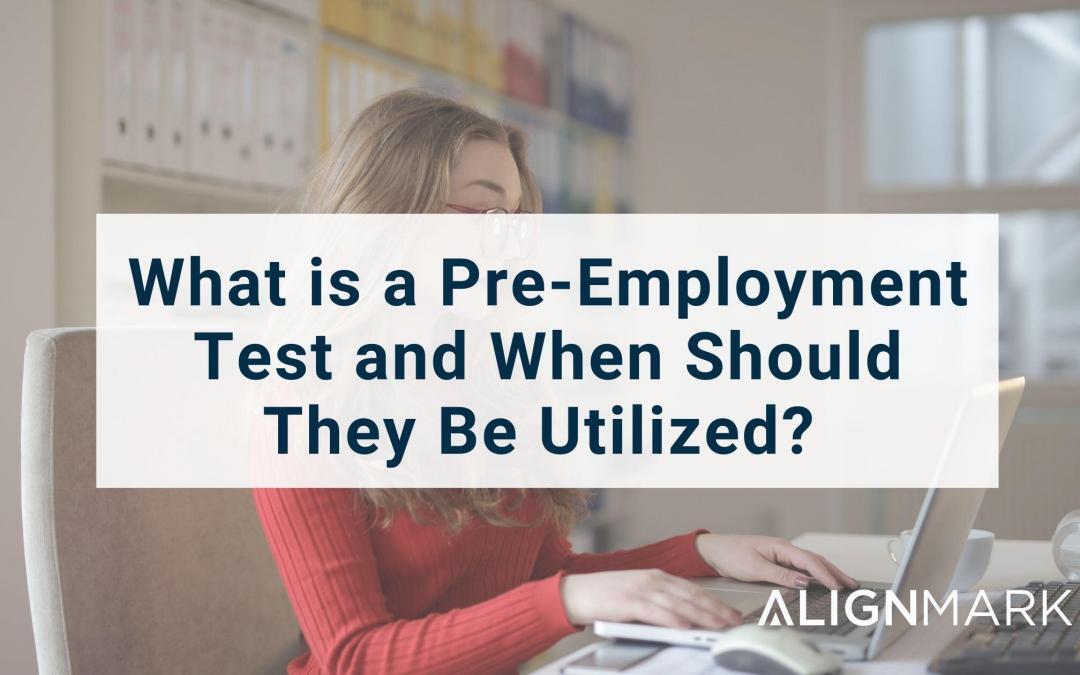Table of Contents
Understanding what a pre-employment test is and when should they be utilized
Most companies realize that their human capital (i.e., people) are their greatest asset. Therefore, more care and diligence should be put into finding the right person for the job compared to the amount of time and effort companies spend choosing equipment or technology. Companies tend to put lots of time and care into choosing equipment (i.e., get 3 quotes, submit proposals, negotiate terms, etc.). If people are truly an important asset for organizations then equal, if not more, care should be put into the hiring decision. This is where pre-employment tests come into play.
Most people agree that a company’s Pre-employment tests are gaining more and more popularity with hiring managers year over year. With COVID-19’s impact on overall unemployment and the need for companies to get the right people in the right seats, pre-employment tests are a great tool to help find the right person for the job. So, what is a pre-employment test or assessment as some like to refer to it as?

What is a pre-employment test?
Pre-employment tests are assessments that are given to job applicants as part of the hiring process. Where they come in the hiring process is up to the company and depends on the position being filled, the validity (predictability) of the test, the time the test takes to complete, and many other factors. Normally, they come somewhere in the middle of the process. The whole idea is for organizations and hiring managers to use pre-employment tests in order to help predict the candidate’s chances of having success on the job prior to offering the job. If they can better fill the position with the right person, chances are that they will also decrease turnover, increase productivity, have a happier employee, and ultimately save the company money over the long haul. Assessments come in many different shapes, sizes, and flavors, and when you use the “right” test you will have a significant impact on hiring and the organization’s bottom line.
When should pre-employment tests be used?
In almost every case, companies will make better hiring decisions using the correct pre-employment assessment versus not using (or using the wrong) assessment. However, there are a number of different scenarios when pre-employment assessments would be particularly valuable. Let’s take a look at some of the factors that almost demand the use of a pre-employment assessment.
Top 6 signs that pre-employment tests should be utilized in the hiring process
1. High turnover
There are many positions such as, call center representatives, truck drivers, correctional officers, security guards and many others that inherently will have high turnover. With even a 5% improvement in turnover a company will realize significant cost savings (could be millions) for the company.
2. High-volume hiring needs
When companies are having to hire for positions that require high-volume, meaning they are hiring 100’s of people at a time – using pre-employment tests can be a good way to make the process more efficient for the hiring managers, limiting the amount of interviews that need to occur.
3. High-volume of resumes per job opening
Similar to number two on this list, when companies are receiving 100’s or thousand’s of applications for one position it can be a daunting task for the hiring manager to get through all the applications efficiently. Adding a pre-employment assessment to the process not only makes the process more efficient, it typically leads to better hiring decisions because more people are considered and have had a chance to make their way through the process than a normal process of interviewing until you find someone who you feel fits well.
4. Specific skill required for position
This is a no-brainer for hires such as engineers, software developers, graphic designers, accountants and so on. Assessments are better equipped to measure specific skills compared to the interview. The interview is not as effective as a pre-employment assessment in measuring the technical skills needed for a job.
5. Need for unbiased hiring process
Companies across the globe are trying to institute hiring processes that eliminate bias in hiring. Using pre-employment assessments greatly helps this process, especially when using proven assessments that make that part of the hiring process completely unbiased. This will have a great impact on Diversity and Inclusion (D&I) initiatives that may be in place within the organization.
6. Desire to find top-performers with more regularity
Let’s face it, the name of the game is to have as many top-performers on staff as possible. When using a statistically valid pre-employment assessment, there is no question that you will have greater success in finding top-performers.
Now, not all pre-employment assessments are the same. You can’t just put together any list of questions and think that you’ll get the results you need (i.e., better hires, lower turnover, etc.). And any instrument used to evaluate candidates can come under the scrutiny of the legal system in terms of Equal Employment Opportunity (EEO) considerations. What is critical when examining legal defensibility issues are the merits of the particular instrument and the credibility of the test developer. The credibility of the test developer entails their academic credentials, experience in the field, and most critically, their personal success in defending instruments previously challenged in court.
In conclusion, if your hiring process is not utilizing pre-employment assessments, chances are you are working harder, not smarter to find the right people to put into the right seats. Review your process, consider where an assessment should fit in the process and then find one that meets your needs.
Related Resource: Pre-employment Assessments: Everything you need to know
Related Blog Post: Why you should use predictive analysis in talent acquisition


 Dr. Jaffee (M.A., Ph.D.) is a recognized expert in the field of assessments, and has created effective HR Solutions used by millions of people.
Dr. Jaffee (M.A., Ph.D.) is a recognized expert in the field of assessments, and has created effective HR Solutions used by millions of people.